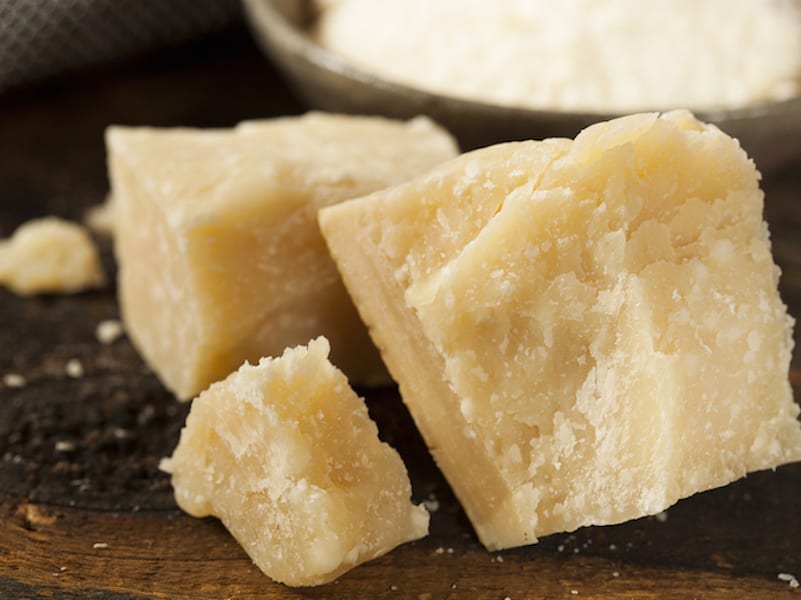Parmigiano Reggiano, it is one of the best-loved cheeses in the world, the hero of many dishes that make up the Italian culinary heritage. It is also one of the most “imitated” cheeses (the most counterfeited, with the name “Parmesan”) but the original Parmigiano is only made in Italy, and that’s what gives the unique flavor to even a seemingly simple dish of pasta with tomato sauce and grated Parmigiano. Like any Italian culinary product, this delicacy has very ancient origins, dating back to 1200.
Parmigiano was born between the monasteries of Parma and Reggio-Emilia (Northern Italy). Thanks to the abundance of rivers and wide pastures, in this limited area of Emilia the making of this hard cheese spread, obtained through the processing of milk in large boilers. A milk with a particular aroma that characterizes the cheese.
Today, Parmigiano-Reggiano is prepared just as it was nine centuries ago, with the same shape and unmistakable flavor. It is identical because it is made with the same ingredients, precious milk from the area of origin, natural rennet and no additives. The story of Parmigiano-Reggiano today is that of small artisan dairies of the area, representatives of about 4000 farmers-milk producers that have received by law the PDO recognition to keep the processing method of the cheese unchanged and to keep producing high quality cheese.
A shape of Parmigiano-Reggiano cheese must have a variable weight between 24 kg and 40 kg. To produce a form of Parmigiano-Reggiano it must have, approximately, 550 liters of milk with an average of more than 14 liters per kilogram of cheese produced.
Quoted in the most ancients manuscripts, recipe books and various documents, Parmigiano was much loved by Napoleon Bonaparte who ate it with a dish of green beans. Alexandre Dumas, author of “The Three Musketeers”, wrote a gastronomic dictionary, devoting more than one line to the Parmigiano. His passion for the typical cheese of Parma was great to the point that he cooked for his guests macaroni with sauce and Parmigiano. Finally Molière, according to biographers, on his deathbed, asked for Parmigiano.
Parmigiano has good nutritional properties, beginning by the high presence of calcium. It is also rich in protein, potassium, magnesium, zinc, and has many vitamins, such as A, B6 and B2.
Each year, there are about 3 million Parmigiano shapes produced, and then sold in Italy and exported to 48 countries around the world. Each dairy company (400) collects the milk and produces no more than 20 pieces per day. Here lies the secret of the quality of Parmigiano Reggiano. The processing is complex, and is an index of quality of the product. The milk from the evening milking, arrives in dairy company and is placed in large steel tanks where it stays all night. The following day, the cream surfaced (used to make butter) is removed and is added to the milk of the morning milking. Here begins the work of the dairyman: coagulation occurs with calf rennet, the curd is broken and collected in molds where it takes on the characteristic shape.
After a few days, begins the phase of the salting, practiced for about 20-30 days. Subsequently, there is the maturation phase, which can last from 12 to 24 months. Before arriving on the market each cheese are checked one by one, tested with a special hammer-tuning fork that reveals, with its sound vibrations, if the dough inside is perfectly secure. At this point, the central mark is applied on the two faces of the form, repeated over the entire circumference.
Parmigiano is a table cheese but it also can grated. For table consumption, it is a general rule to enhoy the cheese aged for a minimum of 12 months while, for grating, you should choose a seasoned for at least 24 months or more (also called extra-mature).
Often, Parmigiano pieces are packed under vacuum, since the cheese can be kept longer, however, in the refrigerator can be kept wrapped in a plastic film.
In Italy, the economic value of Parmigiano Reggiano is so high that several Italian banks, take the product to guarantee the granting of a loan to the same producers.













